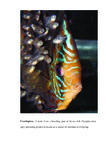Parental care and the development of the parent offspring conflict in discus fish (Symphysodon spp.)
| dc.contributor.supervisor | Henry, Ted | |
| dc.contributor.author | Buckley, Jonathan | |
| dc.contributor.other | School of Biological and Marine Sciences | en_US |
| dc.date.accessioned | 2012-06-19T10:58:55Z | |
| dc.date.available | 2012-06-19T10:58:55Z | |
| dc.date.issued | 2012 | |
| dc.identifier | 798341 | en_US |
| dc.identifier.uri | http://hdl.handle.net/10026.1/1041 | |
| dc.description.abstract |
Parental care has evolved across the animal kingdom to increase the probability of offspring surviving in an environment fraught with danger. While parental care is common among mammals and birds, it is relatively rare in fish with the vast majority of fish showing no form of parental care at all, whilst those that do, often just provide parental care to developing eggs pre-hatch. The provision of parental care in discus fish (Symphysodon spp.) is, therefore, interesting in that parents provide mucus to offspring as a source of nutrition during the first few weeks of care. In mammals this post-birth provision of parental care can lead to the development of the parent offspring conflict. It is, however, possible that this conflict is also present in discus fish. This thesis examines both the interesting parental care strategy of discus fish along with the potential for the parent offspring conflict to develop. To examine the dynamics of parental care in discus fish, a range of behavioural and mucus composition studies were carried out. The analysis of mucus revealed that similar to mammals, parents provided offspring with an initial high quantity of nutritional and non-nutritional factors including antibodies (IgM), essential ions and hormones. Behavioural studies also revealed that initially parents were highly diligent in providing care to offspring but that after two weeks of care, the behaviour of parents changed making it harder for offspring to obtain mucus. At this point a weaning period was initiated where offspring began spending less time with parents and more time foraging for external food sources. The initiation of this weaning period suggests the presence of the parent offspring conflict and indicates that a point is reached where the energetic demands of offspring are too great and that energy is better invested in to future offspring. Research into the bite size and feeding rate of fry suggest that during the weaning period fry could demand excessive amounts of mucus, which may be energetically unsustainable leading to the observed offspring avoiding behaviour of parents. As parental care behaviour is known to be intimately associated with mate choice, mate choice behaviour was also assessed in discus fish with the hypothesis that the ability to provide mucus would be selected for by prospective mates. While my dietary experiment did not influence mucus quality, the mate choice experiment did reveal the importance of hierarchies in discus fish, indicating that dominant individuals were significantly more likely to pair than subordinates. This is similar to that observed in closely related cichlids where the ability to be dominant and protect a territory was indicative of the ability to successfully raise offspring. In conclusion, the parental care behaviour of discus fish appears to share more similarities with that seen in mammals than that observed in fish. The implications of these findings indicate that parental care in discus fish could be a new model of parent offspring conflict hitherto unseen in fish which could ultimately help our understanding of the evolution of parental care in fish. | en_US |
| dc.description.sponsorship | Leverhulme trust | en_US |
| dc.language.iso | en | en_US |
| dc.publisher | University of Plymouth | en_US |
| dc.subject | Parental care | en_US |
| dc.subject | Mucus | |
| dc.subject | Symphysodon | |
| dc.subject | Cichlid | |
| dc.title | Parental care and the development of the parent offspring conflict in discus fish (Symphysodon spp.) | en_US |
| dc.type | Thesis | |
| dc.identifier.doi | http://dx.doi.org/10.24382/3775 | |
| dc.identifier.doi | http://dx.doi.org/10.24382/3775 |
Files in this item
This item appears in the following Collection(s)
-
01 Research Theses Main Collection
Research Theses Main


